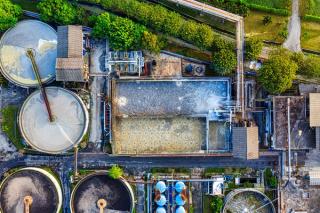
Working Together to Reduce Wastewater Contaminants
- Post Date
- 30 March 2023
- Read Time
- 3 minutes

For decades, SLR has been helping clients evaluate contaminants in their waste streams, including municipal effluent, and we have learned a lot.
You’ve likely heard stories about problematic chemicals being found in the lands and waters surrounding our communities and the greater ecosystem upon which we depend, but did you know that many of these chemicals are coming from diffuse sources, like our homes, workplaces, and everyday goods and materials? Items like textiles (e.g., carpets, drapes, furniture, clothing), food-packing, cookware, and cleaning supplies in our homes and workplaces and the leachate from our landfills are all common sources of many problematic contaminants, including per- and polyfluorinated alkyl substances (PFAS), polybrominated diphenyl (PBDEs), chlorinated alkanes, and organophosphates.
Many of these chemicals make their way into municipal sewers from cleaning water, stormwater infiltration and inflow, or landfill leachate, eventually ending up at a municipal wastewater treatment plant (WWTP). However, most WWTPs aren’t designed to handle many of the more persistent chemicals that are entering our sewers, and if these chemicals aren’t degraded, they are likely making their way back into the environment.
We believe everyone can play a part in tackling this complex problem, and we are working to help our communities, and government and industry partners identify solutions. For change to happen, we all need to step up. Below are a few suggestions where you can help make an impact:
Educate yourself. Reflect on what you’re sending down the drain and take some time to learn about the chemicals in your home, workplace, and wastewater, including those chemicals that have been identified as problematic for your region.
Be a conscientious consumer. Take some time to learn about safer alternatives that don’t contain, or contain lower levels, of hazardous chemicals. If unsure, generally aim towards purchasing products that have independent green/sustainable verifications where available. For larger purchases, like home carpets and furniture, you might have to do a bit more homework but be aware that there are verifications and sustainable buying practices for these too. Think about the full life-cycle of a product, including environmental considerations for the place where it’s made, all the way to how the product will be handled at the end of its life.
Follow product labels and use responsibly. It’s intuitive, but the fewer chemicals we send down the drain the better. Make an effort to be conscious of the quantities of chemicals you’re sending down the drain. Have personal care products, cleaning products, or other home-maintenance products expired? Don’t flush. Look into how the expired product can be recycled or disposed of in your area, this includes pharmaceuticals that should be dropped off at your local pharmacy.
Spread the word! Talk with family, friends, and co-workers about what you’ve learned. All levels of society are part of the solution. Inquire with your employers and local government leaders to learn about what they are doing to understand and mitigate pollution. Ask if they have heard of sustainable procurement as a tool to help reduce pollution.
At SLR, we love to share what we’ve learned and help make our communities more sustainable. If you’d like to learn more about this issue and how you can reduce problematic chemicals in your home, workplace, and supply-chain, get in touch.
Recent posts
-

-

Industrial noise compliance in Alberta: Understanding Directive 038 and Rule 012
by Arthur Kupper
View post -
